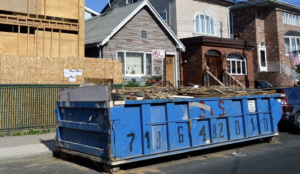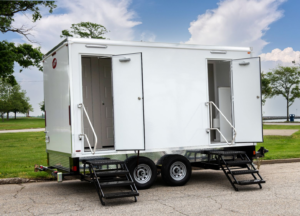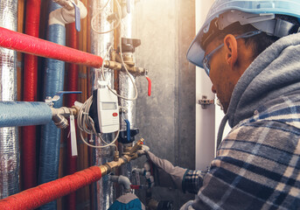Dumpster Rental Maryland is a great way to get rid of trash and debris. However, there are some things you should keep in mind before renting a dumpster. For example, you must consider the type of waste you want to dispose of.
A dumpster is a movable waste container that is brought and taken away by a special collection vehicle. There are several different types of dumpsters, including front-load and roll-off.

If you are disposing of large quantities of waste, a dumpster rental may be an ideal solution. These containers can handle a variety of types of garbage and are able to be transported by trucks for disposal. They are also a safe option for construction projects and home renovations. However, it is important to know what type of waste can and cannot be disposed of in a dumpster. Some types of waste are dangerous and can be harmful to the environment. If you are unsure what type of waste you can throw away, it is best to contact the dumpster company to learn more about their rules and regulations.
You can use a dumpster to dispose of most household waste, including food scraps and yard debris. You can even dispose of larger items like furniture and appliances. However, there are some things that you should not put in a dumpster, such as paints, chemical cleaners, gasoline tanks, Freon, and hazardous materials. These items can pose a danger to the health and safety of the workers who are handling the garbage.
In most areas, a dumpster can be placed on the street or private property. However, you may need a permit to do so. It is a good idea to check with your local waste management office to find out if you need a permit or not.
Many dumpsters are designed to hold heavy waste, such as bricks and stones. However, they come with weight limits. If you place too much heavy waste in the dumpster, it could exceed the limit and cost you extra money. For this reason, it is recommended that you break down heavy items and spread them out evenly throughout the container.
Dumpsters can also be used to dispose of e-waste, which includes electronics and computer equipment. E-waste is often recycled, which helps reduce the need to manufacture new products. In addition, it helps save energy and resources. You can recycle most e-waste at your local recycling center. In addition, you can donate some e-waste to charity organizations or reuse it for other purposes.
One of the most important considerations when renting a dumpster is choosing the right size. There are several different sizes available, and each has its own cost. Generally, the larger the dumpster, the more expensive it will be. However, the exact cost depends on what type of waste you are disposing of and how much it weighs. You will also need to consider the space required to place the dumpster. For example, if you have limited space on your property, it may be best to choose a smaller dumpster.
Dumpsters are typically sized in cubic yards. A cubic yard is equal to the volume of a box that is 3 feet by 3 feet by 2 feet, or about the size of a refrigerator. The most common dumpster sizes are 10 and 20 cubic yards, but you can find many other options as well. When determining the size of a dumpster, it is important to take into account the type of waste you will be dumping and how much space you have on your property.
Choosing the right dumpster size can save you a lot of time and money. If you rent a dumpster that is too small, you will need to make multiple trips to the dump, which will be very costly. On the other hand, if you rent a dumpster that is too large, you will need to pay for extra space you don’t use.
If you’re not sure what size dumpster you need, ask the company to do an on-site inventory of your waste. This will give you a better idea of the amount of waste you’ll need to dispose of, and they will be able to recommend the best solution for your situation. Most dumpster rental companies will do this for free, and they’ll be happy to answer any questions you might have about the process.
If you’re planning a home renovation, cleaning out your house before a move, or getting rid of junk, a dumpster rental is a great way to get the job done quickly and efficiently. The right dumpster size will keep your project running smoothly and save you money in the long run.
A dumpster rental can be a cost-effective way to dispose of trash. A local supplier will deliver the bin to your driveway and remove it after you fill it. The rental period typically lasts from 5-10 days, and you can discard waste by throwing it over the side panel or walking it into the walk-in double doors (if your supplier offers that option). Then, when you’re ready to have it picked up, you call your local supplier to arrange a time.
There are several factors that affect the price of a dumpster rental. These include dumpster size, location, and supply and demand. A larger dumpster is generally more expensive than a smaller one, because it holds more debris. It’s also important to choose a dumpster that’s the right size for your project. If you rent a container that’s too small, you may have to pay overage fees. On the other hand, if you rent a container that’s too large, you’ll end up paying more in rental costs than you should have.
Homeowners or renters often rent a dumpster when they need to do a major cleanup. This can be caused by a landscaping or construction project, moving to a new home, or cleaning out the garage or shed. Sometimes, homeowners will also rent a dumpster when a relative passes away and their estate needs to be cleaned out.
Dumpster rental prices are based on the size and type of dumpster, the location of the project, and the length of time you need to rent it for. It’s important to compare quotes from different companies and find out which has the best rates for your specific project. You should also ask about extra charges, such as delivery fees and dump or landfill fees. Depending on your area, permits may be required for residential dumpsters.
Whether you need a small, medium or large dumpster rental, it’s always better to get everything prepared beforehand. For instance, it’s a good idea to break down boxes before the dumpster arrives. This can save you time and money, as well as ensure that the junk is disposed of properly. You’ll also want to make sure that the area where you’re going to place the dumpster is flat, and that there’s enough room for the truck to maneuver.
When you rent a dumpster, you need to know where to put it. You should select a spot that can hold the container without blocking traffic or creating an eyesore. The location should also be accessible to the truck that will pick it up and drop it off. If you are unsure of the best place to place the dumpster, consult with your waste management company.
You may need a permit to rent a dumpster, depending on where it will be placed during use. If you plan to keep it on your property, such as in the driveway or front yard, you probably won’t need a permit. However, if you want to place the dumpster on public land, such as on a sidewalk or street, you will likely need a permit. You can check with your local city hall to see what you need to do to obtain a permit.
While dumpsters can be used to dispose of many types of waste, they are not intended for hazardous materials. These include electronics, batteries, paint, tires and motor oil. Most dumpster rental companies prohibit these items from being thrown in their dumpsters. Some rental companies have specific spots for hazardous waste, such as a fenced-in area behind a business.
Another thing to keep in mind when renting a dumpster is that it will have a set weight limit. You will pay extra for every ton of waste that you exceed this limit. This is why it is important to read the fine print of your rental agreement.
Dumpsters can be helpful in many ways, whether you’re renovating a home or cleaning out an office. They are easy to use and can make your project more manageable. Using a dumpster can also save you time and money, and is a great way to get rid of unwanted junk. But, the process of renting a dumpster can be stressful. If you’re looking for a junk removal solution that is more convenient and less stressful than renting a dumpster, consider hiring a professional. A professional junk removal service will eliminate the need to secure a permit for an ungainly dumpster or guard it against drive-by dumping.



